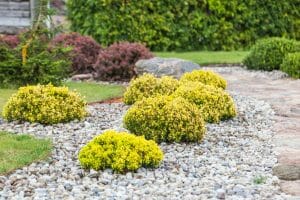
 Low-maintenance landscaping is like the holy grail of home improvement. Lots of homeowners want to install low-maintenance landscaping, but for many, this goal seems unachievable. Is a “set it and forget it” yard an actual thing that exists, or is it a figment of the imagination?
Low-maintenance landscaping is like the holy grail of home improvement. Lots of homeowners want to install low-maintenance landscaping, but for many, this goal seems unachievable. Is a “set it and forget it” yard an actual thing that exists, or is it a figment of the imagination?
All yards require some kind of maintenance if they’re going to continue to look beautiful, but some yards are much easier to maintain than others. As a homeowner, there are many things you can do to make your yard beautiful and easy to maintain. These tips can help.
Focus on Perennials
Annuals need to be planted every year, but perennials do not. Some homeowners like the act of reinventing their flowers and landscaping every year, but you can reduce your yard maintenance by many hours if you replace those annuals with perennials that carry forward year to year. When choosing a perennial, match the plant’s growing zone with the growing zone where you live (Ohio’s growing zones are 5a and 5b) or the perennial will likely die over the winter. Know the size and growth potential of the plant. Some perennials get quite large because they add to their growth annually.
Shop For Native Plants
Native plants are plants that grow naturally in your area and thus need little care in order to survive. Though native plants sometimes look better when they receive some supplemental care, they do not require it. Planting native plants on your property means minimal watering and fertilizing. You may still need to prune or deadhead throughout the growing season, so don’t forget to research the plants you select before installing them in your yard.
Install Hardscaping
Hardscaping is a naturally low maintenance landscaping feature because, unlike plants, hardscaping needs no watering, pruning or fertilizing. Some hardscaping does need some care, so choose your hardscaping well, and use a professional.
For example, a wooden deck needs refinishing periodically, while a composite deck does not. Consulting with a professional when choosing your materials and then hiring that professional to perform the installation will help ensure that the hardscaping requires as little work as possible throughout the season. If you try to install hardscaping yourself, the work may not last as long and you may find yourself redoing it in a few short years.
Plant Evergreens
Evergreens don’t shed leaves throughout the season the way deciduous trees and shrubs do. Planting evergreens means no fall clean up, though you may find yourself occasionally raking pine needles, as evergreens do lose their needs, but less frequently.
Group Plants by Watering Needs
Some plants need a lot of watering while other plants need far less. Grouping plants by watering needs means that you can set up your sprinkler system to water sections of the yard automatically, delivering a targeted amount of water to each section. If you combine plants that have different watering needs in one section, you’ll have to water each plant individually and do it by hand. This will take a lot more effort.
Replace Grass with Ground Cover
Grass needs regular trimming, watering, fertilizing and weeding, and if you don’t keep up this routine throughout the summer, your grass could quickly grow out of control. You can reduce yard maintenance by replacing grass with ground cover. These plants require no weeding because they tend to choke out the weeds by shading the ground and sucking up the water. Ground cover also requires no trimming, except to keep the ground cover in the part of the yard where you prefer it to grow.
Keep Out Weeds With Barriers
Weed barriers are clothes laid under a few inches of soil or mulch to prevent weeds and unwanted plants from growing in the area. Weed barriers are used in flower beds and can also be used in garden beds around vegetables to control what grows there. Install weed barriers to prevent weeds from growing up around your flowers and shrubs.
Know the Plants Before You Plant Them
Nearly every plant needs some kind of maintenance. Some plants need continuous deadheading throughout the blooming season in order to keep producing fresh blossoms. Other plants produce a layer of debris and leaves that need to be picked up throughout the growing season. Some flowers will grow out of control if not regularly pruned back, while others die back every season and re-grow anew, requiring the gardener to remove the debris and sticks left behind every winter.
Knowing these growing habits before you buy a plant can help you choose the shrub that requires maintenance you can handle. It’s also important to know the fertilizing and light requirements so you can match the plant to the right part of the yard. Installing a plant in the wrong part of the yard could lead to a constant struggle to keep that plant healthy – and that means more work for you.
Work With a Pro
Setting up a low-maintenance yard can be a lot of work! You can make this easier for yourself, and you can more effectively set up a low-maintenance yard, if you work with a professional landscaper. Working with a pro, you’ll be able to tell the landscaper what your goals are, what level of maintenance you can realistically handle, and you can talk about your aesthetic preferences.
Your landscaper will take this information and turn it into a low-maintenance yard you’ll love. For more information about how you can install a low-maintenance yard on your property, contact Ohio Valley Group for a consultation. With over 30 years in the landscaping business, we’ve helped hundreds of homeowners like you achieve their goals, and we can help you, too.
